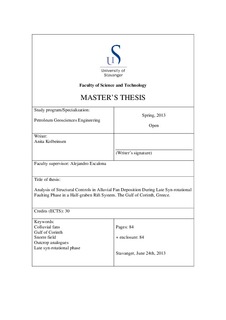| dc.contributor.author | Kolbeinsen, Anita | |
| dc.date.accessioned | 2013-11-14T09:49:55Z | |
| dc.date.available | 2013-11-14T09:49:55Z | |
| dc.date.issued | 2013-06-24 | |
| dc.identifier.uri | http://hdl.handle.net/11250/183579 | |
| dc.description | Master's thesis in Petroleum geoscience engineering | no_NO |
| dc.description.abstract | The Kalavrita region is located at the southern margin of the Gulf of Corinth, Greece, and is considered a perfect academic and research laboratory to study the evolution of rift systems and the interaction between tectonics and sedimentation. Furthermore, individual faulted blocks, represent up to scale analogues to many rifted blocks and hydrocarbon fields at the Norwegian Continental Shelf. The wedge shaped structure situated in the hanging wall of the Dhoumena east fault was mapped in order to understand its geometry, provenance and relation to the fault and neighboring faulted blocks, e.g. the Kerpini fault. Field observations suggest that studied wedge shape is a debrisflow colluvial fan, fed from the Dhoumena footwall or Kerpini fault block and down the relay-ramp. To implement the lessons learned in the field to subsurface data, the clastic wedge shaped syn-rift structure situated in the hanging wall of Inner Snorre fault, close to the Snorre field in the North Sea, was mapped. In the Norwegian sector, these Jurassic to Lower Cretaceous wedge shaped hydrocarbon reservoirs represents underexplored hydrocarbon plays. In contrast, across the border in the UK sector, they are producing from comparable wedge shaped strata. To explore if these syn-rift exploration plays could be profitable in the Norwegian sector, volume calculations and a study of reservoir properties were conducted. Observations of sandyfacies and calculated volumes of 11 – 12 mmboe, suggest that for a smaller oil company, the studied clastic wedge represents an attractive play, given the existing infrastructure in the region. | no_NO |
| dc.language.iso | eng | no_NO |
| dc.publisher | University of Stavanger, Norway | no_NO |
| dc.relation.ispartofseries | Masteroppgave/UIS-TN-IPT/2013; | |
| dc.subject | petroleumsgeologi | no_NO |
| dc.subject | colluvial fans | no_NO |
| dc.subject | Gulf of Corinth | no_NO |
| dc.subject | Greece | no_NO |
| dc.subject | Late syn-rotational phase | no_NO |
| dc.subject | Hellas | no_NO |
| dc.subject | Snorre field | no_NO |
| dc.subject | Norwegian sector | no_NO |
| dc.subject | outcrop analouges | no_NO |
| dc.title | Analysis of structural controls in alluvial fan deposition during late Syn-rotational faulting phase in a half-graben rift system. The Gulf of Corinth, Greece. | no_NO |
| dc.type | Master thesis | no_NO |
| dc.subject.nsi | VDP::Technology: 500::Rock and petroleum disciplines: 510::Geological engineering: 513 | no_NO |
| dc.source.pagenumber | 84 | no_NO |
